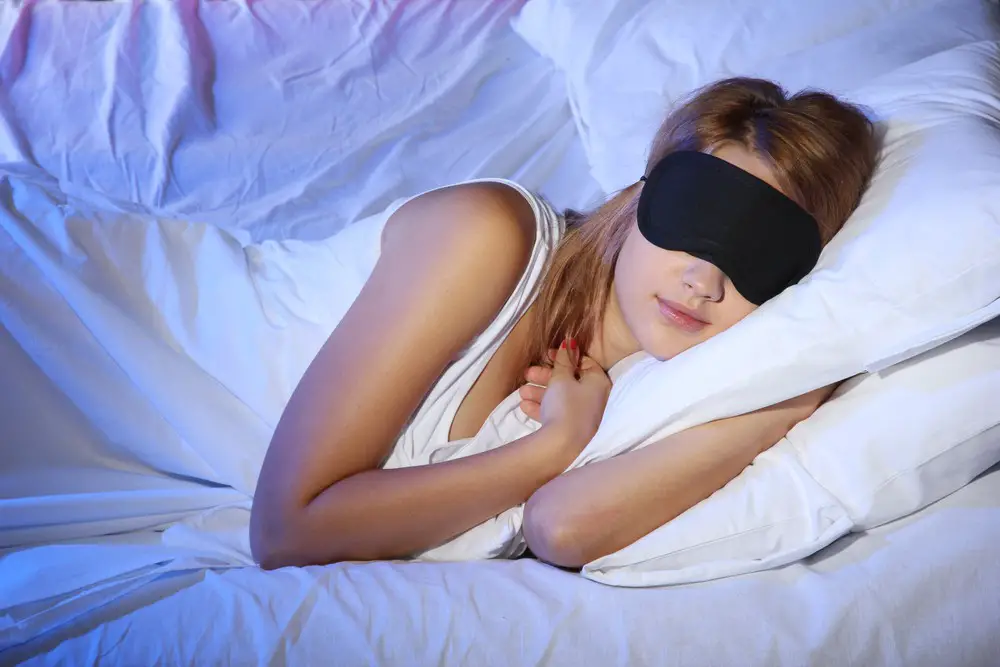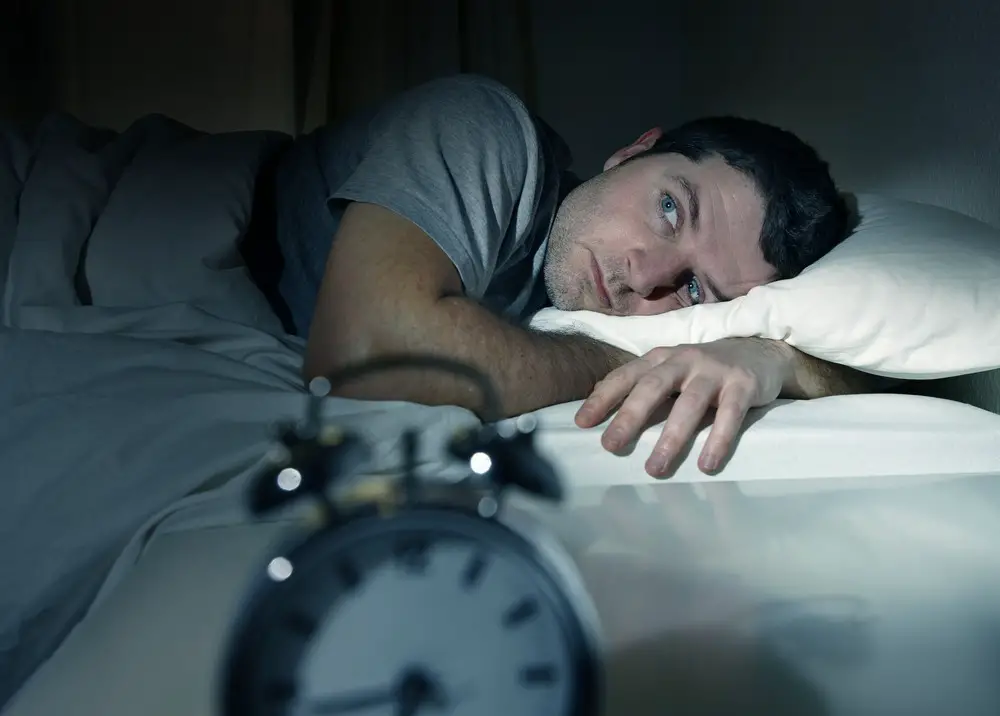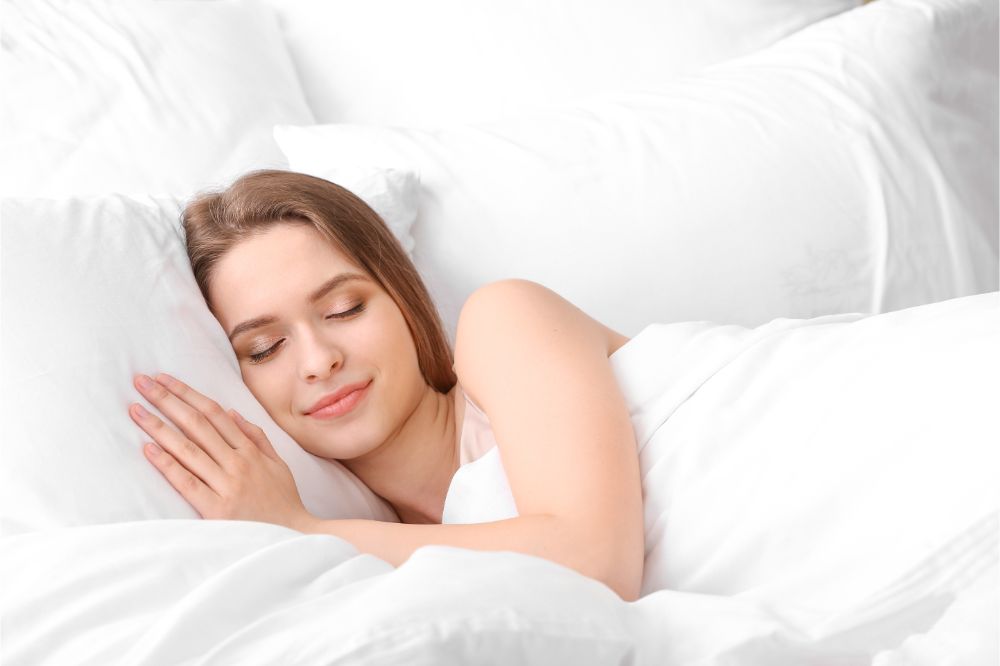As a BetterHelp affiliate, we receive compensation from BetterHelp if you purchase products or services through the links provided
Have you ever wondered what happens to your eyes when you drift off to sleep? Are your eyeballs rolling back, or do they remain in place? It’s a common question and one that often leads to some interesting discussions about the workings of our eyes during sleep. In this article, we will explore the various aspects of eye movement during sleep and debunk some of the myths surrounding this natural bodily function.
Our eyes go through several stages when we sleep, each with unique characteristics. The movement of our eyes during sleep is complex. It is influenced by factors such as our sleep phase, the presence of any underlying medical conditions, and in some cases, the type of dreams we are experiencing. Understanding eye behavior during sleep can help individuals address potential sleep-related issues and ensure better eye health in the long run.
Key Takeaways
- Eye movement during sleep varies depending on sleep phases and underlying health conditions.
- Normal sleep involves rapid eye movement (REM) and non-rapid eye movement (NREM) stages.
- Maintaining good eye health can help prevent sleep-related eye issues and support overall well-being.
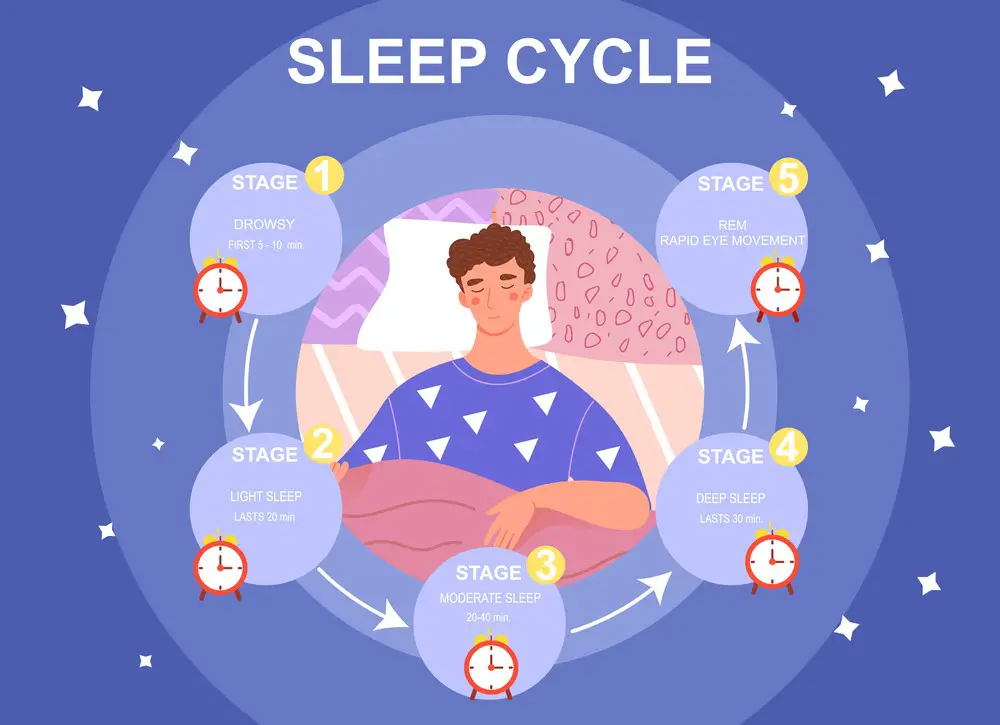
Understanding Eye Movements
When it comes to eye movements during sleep, a lot is happening behind closed eyelids. The human eye possesses a remarkable range of motions, including nystagmus, saccades, and rapid eye movement. These eye movements are essential for visual processing, and their behavior during sleep is a fascinating area of exploration.
Our eyes perform nystagmus, a set of involuntary, rhythmic oscillations. Often linked to balance and coordination in daily life, this eye movement can also be observed during sleep. Scientists believe that nystagmus serves a purpose, but its exact function remains debatable.
Next up, saccades are rapid, abrupt eye movements that occur when shifting focus from one point to another. Picture yourself scanning the pages of a book—the eyes dart swiftly and skillfully from one word to another. Saccades also appear during slumber, especially in the REM sleep stage.
Surprisingly, rapid eye movement (REM) is not just the name for one of our sleep stages; it also characterizes a specific type of eye movement. As you may have guessed, REM sleep is characterized by quick, random eye movements. This stage of sleep is often associated with vivid dreaming and enhanced brain activity. During REM sleep, the brain seems to be bustling with energy, and the eyes follow suit, darting to and fro with gusto.
Responding to the original question, do your eyeballs roll back when you sleep? The answer is not so simple. While some degree of eye movement occurs during sleep, it is not a continuous rolling back. Instead, various eye movements like nystagmus, saccades, and rapid eye movement can be witnessed throughout different sleep stages, with most of the action occurring during REM sleep. Each eye movement type has unique properties, contributing to human sleep’s complex and intriguing nature.
Normal Sleep Phases
Sleep is an essential part of our daily lives, and understanding the phases our eyes and brains go through during those precious hours of rest is fascinating! So, let’s dive into the world of normal sleep phases and reveal where our eyeballs wander while we snooze.
Our body’s internal clock, or circadian rhythm, regulates when we feel awake or sleepy every 24 hours. As nighttime falls and our eyes grow heavy, this biological clock starts guiding us into various stages of sleep.
Initially, we enter the non-REM sleep phase, which consists of three stages. Stage 1 is a light slumber, and our eyes may gently move beneath our closed lids. As we slip into stage 2, eye movement slows significantly, and our bodies prepare for deep sleep.
Ah, stage 3 – this is where the magic happens! We’ve arrived at the deepest part of non-REM sleep, and during this time, our eyes remain relatively still. Our bodies are busy restoring and rejuvenating, ensuring we’re ready for the next day’s adventures.
But wait, there’s more! As our sleep cycle continues, we encounter REM sleep, the stage where our brains become a playground of vivid dreams and rapid eye movement. During REM sleep, our eyeballs come alive, darting back and forth as if trying to keep up with our dreamscapes’ wild escapades.
Interestingly, our sleep cycle doesn’t just stop at one round of non-REM and REM sleep. Instead, it repeats throughout the night, approximately every 90 minutes. Each successive cycle includes a longer duration of REM sleep, allowing our eyes to enjoy a roller coaster ride of movement during these periods.
As daylight peeks through the curtains and our circadian rhythm nudge us toward wakefulness, we must realize how critical these sleep phases are to our overall well-being. A good night’s sleep filled with a healthy mix of non-REM and REM stages ensures we’re ready to tackle whatever the day has in store. So, tuck yourself in, close your eyes, and let the sleep phases whisk you away into a world of rejuvenation and dreams.
Eye Behavior During Sleep
Our eyes are fascinating organs, and their behavior during sleep strikes curiosity. Many people wonder if their eyeballs roll back when they slumber. To answer this question, we must delve into the different phases of sleep and the associated eye movements.
Sleeping consists of two main stages: Rapid Eye Movement (REM) and Non-Rapid Eye Movement (NREM). Throughout these stages, our eyes display distinct responses.
The NREM phase comes first, characterized by limited eye movement. Our eye muscles are largely relaxed during this period, with the pupils constricted and barely shifting. So, the notion that our eyeballs roll back during this stage isn’t quite accurate.
As we shift into the REM phase, things get more interesting. This stage is best known for the vivid dreams we experience. Intriguingly, our eyes exhibit rapid eye movement, living up to the name! They dart back and forth, up and down, mimicking the actions we see in our dreams, as if scanning the dream environment. However, it’s essential to note that our pupils don’t roll back per se; they move directionally, reflecting our dream activity.
Now, let’s take a moment to explore blinking during sleep. While awake, blinking is a crucial function that lubricates and protects our eyes. However, when we’re resting, it’s a different story. Any blinking that occurs is involuntary—our eyes are closed, so there’s little reason to blink consciously.
In summary, our eyes display various behaviors in the different stages of sleep. There’s minimal eye movement in the NREM phase, with no rolling back of the eyeballs. Instead, they remain relatively still. In the REM stage, our eyes dart rapidly but don’t precisely roll back. Finally, any blinking during sleep is purely involuntary, a noteworthy side effect of our fascinating eyes at rest.
Health Conditions and Eye Movements
When it comes to how our eyes move during sleep, there’s more than meets the eye. Some health conditions and issues can actually impact eye movements, even as we slumber. Let’s delve into a few of these factors and see how they influence our eyelids and eyeballs.
Seizures and fainting can also cause a rolling back of the eyes. When these episodes occur, one may lose consciousness, causing the eyes to roll back involuntarily. Recognizing the difference between sleep-related eye movements and those resulting from seizures or fainting spells is important.
Stress can also play a role in eye movements. Elevated stress levels can lead to increased REM (rapid eye movement) sleep, during which the eyes dart back and forth beneath closed eyelids. This rapid movement helps our brains process the emotional experiences from our day.
Furthermore, dry eyes can lead to discomfort during sleep. The production of vital tears decreases at night, leaving the eyes prone to dryness and irritation. Being mindful of nighttime eye care, such as lubricating eye drops before bedtime, can help alleviate this issue.
While melatonin is often hailed for its sleep-enhancing benefits, it’s essential to be aware of the potential side effects. Melatonin can sometimes ironically cause vivid and disruptive dreams, leading to more active eye movements during the REM sleep cycle.
Infections can also alter our eyes’ sleep behavior. Conjunctivitis, for example, can lead to crusting, itching, and puffiness—all of which can cause unintended eye movements or disruptions to sleep. Treating the infection with prescribed medications and maintaining good eye hygiene can help protect our peepers as we rest.
Lastly, night terrors can heavily impact eye movements during sleep. Intensely emotional experiences can cause the eyes to move erratically, even causing some people to open their eyes while screaming or crying out in fear. This unsettling phenomenon underlines the intricate connection between our emotional state and our eyes, even as we sleep.
In conclusion, various health conditions and factors—from seizures to stress—can influence eye movements during sleep. By staying attuned to these potential disturbances, we can better understand and care for our eyes as they rest alongside us.
Eye and Sleep Issues
Sleep, a vital part of our daily lives, can sometimes be accompanied by various eye-related issues. As we delve into the intriguing world of eye behaviors during sleep, it’s important to consider the potential problems that can arise.
Sleep deprivation can sometimes be the root cause of many eye issues. Extended periods without enough sleep can lead to eye strain, making it tough to keep your eyes focused and causing discomfort. The remedy? Make sure you’re catching enough Zzzs.
Now, we can’t forget about caffeine. Downing that cup of coffee might seem like the solution to get through the day, but in larger quantities, it can cause issues such as eye strain and even disrupt your sleep pattern. Stay informed and consume caffeine in moderation—your eyes will thank you.
A terrifying experience known as sleep paralysis can also involve eye issues. In this uncanny state between sleep and wakefulness, a person might be unable to move or even open their eyes, often accompanied by vivid and frightening hallucinations.
Moving on to nocturnal lagophthalmos, this is a condition in which the eyes don’t fully close during sleep, leaving them exposed and often the cause of dryness and irritation. Identifying the underlying factors, such as facial nerve dysfunction or eyelid abnormalities, is essential to find an appropriate solution.
Lastly, we stumble upon proptosis—a condition in which the eyes bulge outward due to an underlying medical issue such as thyroid disease. If left untreated, proptosis can lead to severe eye pain, vision problems, and even damage to the optic nerves.
In conclusion, although our eyeballs might not exactly “roll back” during sleep, the realm of eye and sleep issues is vast and intricate. Acknowledging these concerns and seeking appropriate guidance will help ensure a peaceful slumber while keeping your eyes healthy.
Medical Interventions and Eye Movements
It’s a fascinating subject regarding our eyes and how they behave during sleep. But sometimes, eye movements need medical intervention. Let’s delve into some instances and the relevant procedures.
Surgery might sometimes be necessary to address uncomfortable or atypical eye movements during sleep. For instance, those experiencing sleep-related issues such as sleep apnea might undergo a surgical procedure to alleviate the condition, indirectly improving eye movements as well.
On the other hand, Botox injections could be employed to address issues surrounding eye muscles. These injections temporarily weaken or paralyze the muscles, thus minimizing unwanted or excessive eye movements. Botox has been lauded for its potential to improve eye movements during sleep and other related symptoms.
Eyelid-tightening surgery, a.k.a. blepharoplasty, can also prove beneficial for those who experience eye movements that hinder a comfortable slumber. Excess skin and fat are removed by tightening the eyelids, and the lid’s muscles are strengthened. This results in a more relaxed eye, reducing problematic movements while asleep.
It’s important to remember that treatment options may vary for each individual. Consulting a trusted medical professional is the smartest way to embark on the path to better eye movements during sleep.
In short, sometimes, our eyes need a little help to stay put while snoozing. With the aid of modern medicine and various treatments – including surgery, Botox injections, and eyelid-tightening procedures – we can ensure a peaceful night’s rest while keeping our eyes right where they belong.
Common Misconceptions
There’s a widely-held belief that our eyes roll back when we sleep, causing some to wonder about the rationale behind this phenomenon. However, it’s crucial to debunk this misconception and shed light on the true nature of eye movements during sleep.
Our eyes don’t exactly “rollback” when we drift off to dreamland. What happens is that the eyes undergo rapid movements called Rapid Eye Movement (REM) sleep, a phase characterized by heightened brain activity, vivid dreams, and, as the name suggests, swift eye movements. During this stage, the eyes dart back and forth in various directions rather than rolling back into the head.
On the other hand, during non-REM sleep, our eyes generally remain still or exhibit only minimal movements. It’s worth noting that most of our sleep consists of non-REM stages, which can explain why our eyes may appear dormant sometimes. Hence, the notion that our eyes roll back when sleeping distorts the truth.
So, why do people entertain this idea? The confusion may stem from observing others while asleep, as the eyelids partially cover the pupils, creating an illusion of the eyes being rolled back. Additionally, movies and television often depict characters with rolled-back eyes to dramatically portray an unconscious or trance-like state, further perpetuating this misconception.
In conclusion, the belief that our eyes roll back while sleeping is rooted in misconceptions and false depictions. In reality, our eyes follow a distinct pattern of movements, primarily influenced by our sleep stage. Armed with this knowledge, we can all rest easy knowing our eyeballs remain snugly in place as we snooze soundly.
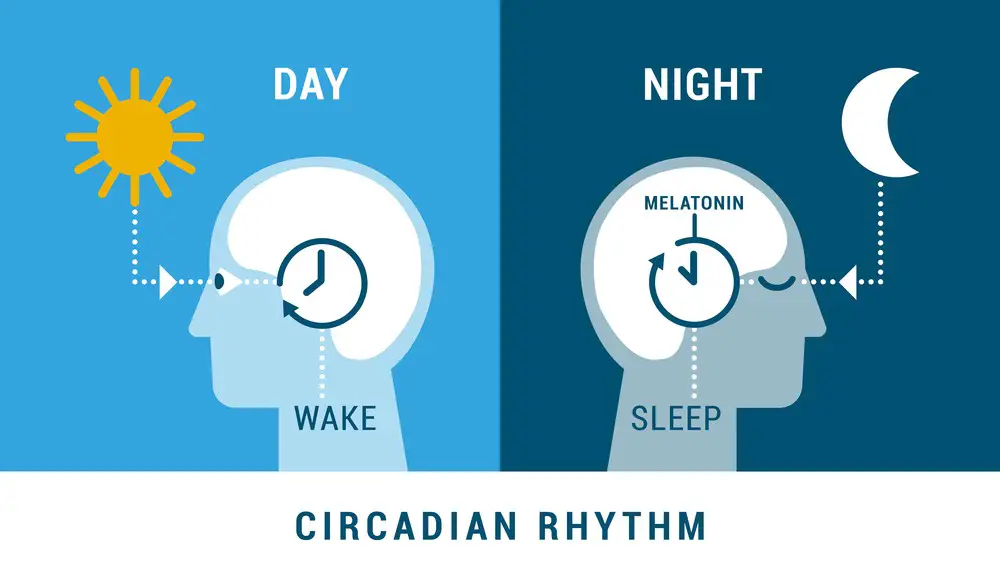
Preventing Eye Issues During Sleep
Our peepers need some rest too! While we enjoy a good night’s sleep, our eyes follow suit as the body restores. While we don’t know if our eyeballs roll back during sleep, we must learn some tips for maintaining eye health during slumber.
First off, let’s talk fluids. Keeping your peepers hydrated plays a significant role in preventing eye infections and related discomforts. Applying lubricating eye drops before hitting the hay can work wonders to keep your eyes moist and refreshed. After all, nobody wants to wake up with parched peepers, right?
Moving on, we’ve got the conjunctiva, a translucent membrane lining our eyelids. Its primary role is to keep dirt, debris, and anything else that might adversely affect our eyes at bay. To help the conjunctiva function properly, consider using hypoallergenic pillowcases and sheets. Not only will this reduce eye irritation, but you’ll also sleep like a baby with these materials.
Now, who doesn’t love a little darkness during slumber? Not only does it help us sleep better, but it also benefits our blood vessels. Reducing exposure to bright lights relaxes the blood vessels around the eyes, optimizing circulatory health and promoting general well-being. So draw those blackout curtains and let your eyes bask in the darkness!
To wrap things up, embracing a healthy eye maintenance routine during sleep is essential. By keeping our eyes hydrated, supporting the conjunctiva, and embracing the power of darkness, we can ensure the eyes recover optimally during some much-needed shut-eye. Sweet dreams!
Additional Considerations
Regarding eyeballs rolling back during sleep, it’s important to ponder key factors. Let’s explore some additional considerations that might illuminate this fascinating topic.
First off, genetics could play a role in whether or not someone’s eyeballs roll back in their head while they sleep. Some individuals might be genetically predisposed to experience this more than others, like how certain traits can be passed down through families.
The inner ear is another element to contemplate. Known for being responsible for balance and spatial orientation, the inner ear could influence eye movement during sleep. If the inner ear detects a change in the sleeper’s position, it might send signals to the eyes, causing them to roll back.
Now, on to eye-rolling in general. Eye-rolling is a universally understood nonverbal signal associated with annoyance or exasperation. However, it’s unlikely that this aspect holds much relevance in eye movements during sleep since the individual is likely not displaying emotions while in a state of rest.
Of course, one cannot ignore the tonic phase of sleep. During this stage, the body transitions into a more relaxed state, and this relaxation may lead to a disposition where the eyeballs are more inclined to roll back. It’s intriguing to consider whether there could be any connections between this phase and the occurrence of eye-rolling while snoozing.
Bell’s phenomenon is yet another factor that warrants further attention. It is an involuntary upward and outward eye movement when the eyelid is forcibly closed. This natural protective reflex may sometimes contribute to the eyeballs rolling back, even if it isn’t the primary reason behind this phenomenon.
In summary, eyeball rolling during sleep might be influenced by many elements, from genetics to the inner ear and the tonic phase to Bell’s phenomenon. While we can’t pinpoint a single determining factor, it’s evident that the human body is a complex and multifaceted system that never ceases to surprise us.
Frequently Asked Questions
Do our eyes move during sleep?
Yes, they do! Our eyes undergo several movements during sleep, especially during the REM (Rapid Eye Movement) stage. During this stage, our eyes move rapidly in various directions, calling it “Rapid Eye Movement.”
What happens to our eyes during REM sleep?
When we enter the REM stage of sleep, our brains become highly active, and our eyes begin to move swiftly and randomly. This eye movement is believed to be related to the vivid dreams we experience during this sleep phase.
Is eye movement related to dreams?
Indeed, it is. Researchers suggest that rapid eye movement correlates with the visual imagery occurring in our dreams. While it’s not entirely clear how these two are linked, it’s fascinating that our eyes are dancing in tune with the stories our minds create.
How do eye muscles function when we sleep?
Most of our muscles relax during sleep, and eye muscles are no exception. In the REM stage, however, eye muscles become more engaged due to the rapid eye movement. This alternating pattern of relaxation and activity helps maintain muscle health and function.
What is the purpose of rapid eye movement?
Scientists have several theories about the purpose of rapid eye movement during sleep. Some believe it’s crucial for processing and consolidating memories, while others think it helps stimulate the brain regions responsible for learning and development. It’s a fascinating area of research, with many questions still waiting to be answered.
Can our eyes open during sleep?
Yes, sometimes our eyes may open while we’re asleep. This phenomenon, known as “nocturnal lagophthalmos,” is not uncommon and can happen to anyone. It’s typically nothing to worry about, but if it causes discomfort or interrupts your sleep, consider discussing it with a medical professional.
- Breaking the Silence: Why Men’s Mental Health Matters More Than Ever - April 15, 2025
- How to Transform a Home’s Patio Space into a Relaxing Space - March 23, 2025
- 5 Strategies to Use a Cell Phone to Help Manage Your Stress - March 23, 2025
This site contains affiliate links to products. We will receive a commission for purchases made through these links.

